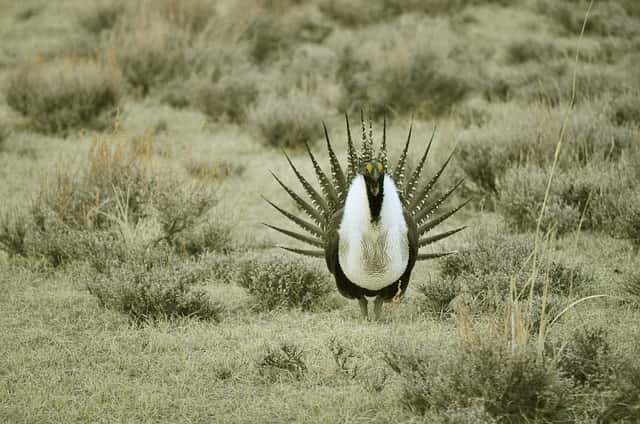By Larry Evans
The Sagebrush Sea grasslands might not look like much to some, but for those that call these areas home, they are nature’s beauty at its very best. They also provide the key element to the enjoyment of a select lifestyle for current landowners and generations to come.
Minimizing Threats
No matter if it is Oklahoma or Montana, it’s hard to explain the emotional feeling attached to land where a family’s ownership began. The “home place” is territory to protect. But, it is continually being threatened by both internal forces, usually through added generations of control and family mobility, and external forces.
The main external threat is typically driven by financial economics. The smaller the size of an owner’s property, the more difficult it is to develop a revenue stream that requires leaving the native sagebrush landscape in place. Converting land use to crops, or residential or commercial development may be considered necessary for overall economic viability by the landowner, but these conversions are perhaps the main threat to the Sagebrush Sea because it disrupts the migratory path of the sage-grouse and pronghorn antelope. Changing a migratory path leads to interrupted mating territories, and ultimately, decreased sage-grouse populations, which could create another external threat that will be discussed.
A sometimes misunderstood opportunity for the landowner to benefit, while still working to sustain or increase the size of the native sagebrush grasslands, resides in the ability to establish conservation easements that allow a landowner the ability to choose to restrict land use from crop or building development conversion, while still providing the land owner financial incentive for allowing the restrictions.
Conservation easements established through the USDA Natural Resources Conservation Service and Regional Conservation Partnership Programs help provide funds to land owners to mitigate the loss of revenue from not converting the land away from the Sagebrush Sea concept. These programs and services also help to inform landowners about other conservation tactics that will improve the land for deep-rooted perennial grasses, reduce the possibility of wildfire, eliminate conifer and weed grass over-population and preserve ranch land for generations into the future.
How the Easements Work
The USDA’s Regional Conservation Partnership Program, a program created by the 2014 Farm Bill, has recently established a $8 Million fund, available to landowners in eastern California and western Nevada, for use to enhance the quality of ranch water.
In a conservation easement, landowners will receive either a cash settlement or a charitable tax deduction to reduce taxes. In return for the receipt of the cash or charitable tax deduction, the landowner agrees to restrict the use of the land away from things that would harm or disrupt the use of the land in its natural state. As a result, the restrictions should prohibit conversion of grasslands to crops, surface mining, new residential road construction, and wind or solar energy development, just to name some examples. However, and this is important, the landowner continues to own the underlying land and can use the easement covered land for normal operations as provided in the negotiated restrictions list. In addition, through easement restriction negotiations, a landowner may preserve certain building areas within the easement for future operation, or family, needs.
One example of the value of a conservation easement to a landowner occurred recently when the Montana Land Reliance, worked with a landowner to complete an easement estimated to provide the landowner benefit of over $3 million, for conserving a little more than 11,000 acres of mixed use land in Golden Valley County.
Viability, for Landowners and Grouse
Why the concern about the sage-grouse? It’s all in the numbers. The sky used to turn black when greater sage-grouse took flight because their number was so great. But that was long ago. Now, the sage-grouse teeters on the edge of being classified as an endangered species. If they’re classified as an endangered species, landowners where sage-grouse live wouldn’t benefit, and neither would the sage-grouse.
Failure is Not an Option
Currently, the greater sage grouse is not listed as an endangered species, but it is still a threat. In 2015, the U.S. Fish and Wildlife Service, based on a new land management plan to protect the remaining millions of acres making up the sage-grouse habitat that stretches across 11 western states, decided to withdraw the species as an endangered species candidate. However, if those land management efforts fail, and the sage-grouse is eventually placed on the endangered list, the private land making up part of the Sagebrush Seas would most likely be restricted in use. This could lead to landowner economic loss through lower land values and limited revenue capabilities caused by undesired land use restrictions. Therefore, keeping the sage-grouse from being listed as an endangered species is in the financial best interest of a landowner, which requires landowners becoming educated on conservation alternatives, whether they are used, or not.
Understand Your Options
Land owners can help control their own destiny by focusing on conservation, either through easements or through the enhancements a landowner can make to preserve the native sagebrush grasslands, thereby, helping to keep the sage-grouse from falling to a population level that would require listing as an endangered species. Fortunately, the programs listed above and other federal and state programs are available to assist in conservation efforts; we know, because we’ve assisted landowners with the process. But, ultimately, it is the responsibility of landowners to understand and take advantage of these conservation programs to create a win for the sage-grouse, a win for the Sagebrush Sea, and, importantly, a win for the financial success and future enjoyment of landowners as they protect their own “home place”.
To learn how to take advantage of conservation easements and if one might be right in your situation, contact Joy Culver (406.896.2428) or Shauna Shafer (303.539.5925) or a local Eide Bailly representative.
Content Sponsored by Eide Bailly




